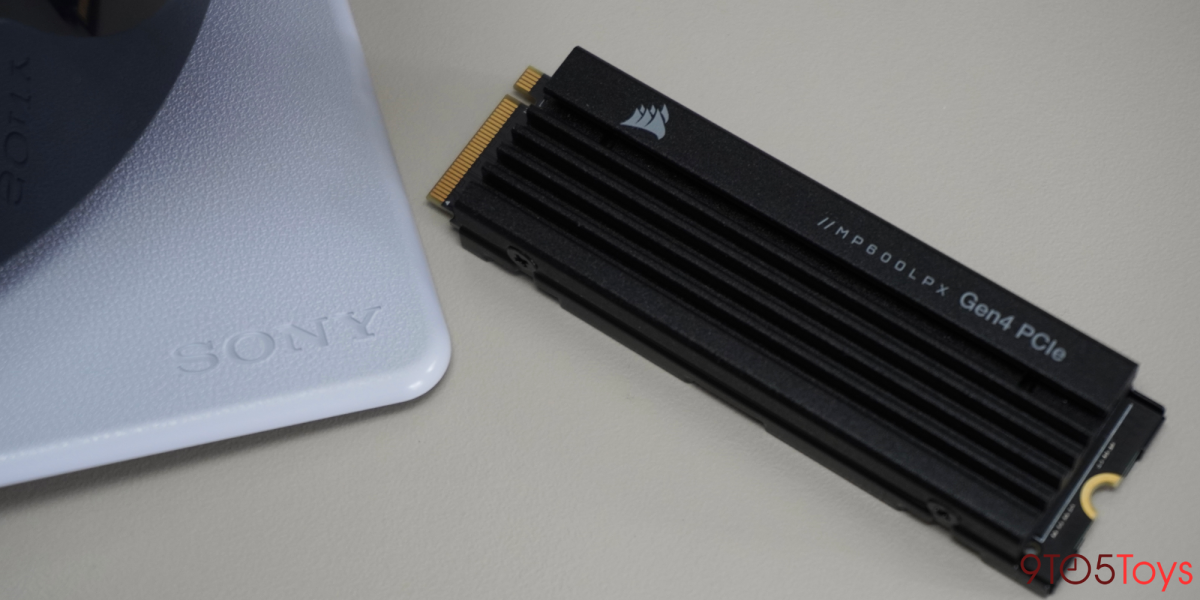Earlier this month, CORSAIR launched its latest internal SSD which took aim at PS5 users looking to supplement the console’s storage. Now that Horizon Forbidden West launched this past weekend with nearly 90GB of required space to enjoy the highly-anticipated sequel, I put CORSAIR’s new MP600 PRO LPX SSD to the test for solving storage woes. Head below for the full scoop on what to expect from the process.
Hands-on with the CORSAIR MP600 PRO LPX SSD
Launching back at the beginning of the month, CORSAIR debuted its latest internal SSD known as the MP600 PRO LPX series. While the name might be a mouthful, the important thing you need to know right off the top is that these M.2 drives come equipped PICIe Gen4 speeds, making them ideal for pairing with the PlayStation 5. Pricing starts at $109.99 for the entry-level 500GB model, and climbs from there up to $359.99 for the 4TB capacity.
Most Gen4 SSDs are capable of meeting Sony’s requirements to support use with a PS5, but CORSAIR is one of the brands that takes things a step further by optimizing the experience. The main fruit of such labor is the built-in heatsink, which helps ensure that the drive can not only achieve up to 7,100MB/s transfer speeds, but it can actually sustain necessary performance over a longer duration.
As far as installation goes, I was fully ready to write up all of the ins and outs of actually getting a PS5 upgraded with a new SSD. But after going through the process, there isn’t too much I can say that Sony itself hasn’t already streamlined in its installation guide. Even though the whole ordeal only takes five minutes, it’s worth going through and giving that tutorial a read-through, just for an idea of what you’re getting yourself into before actually cracking open a PS5. It’s quite minimal as far as replacing an internal drive goes on any device, let alone a console.
With that being said, the actual process of getting the new CORSAIR MP600 PRO LPX SSD installed into a PS5 is as easy in practice as it seems on paper. The drive itself is packaged up quite nicely inside of a foam block in the box that keeps things secure, and then it installs with a single screw into the console.
9to5Toys’ Take:
Even though Sony rolled out support for user-upgradable SSDs on the PS5 a few months ago, I’m sure many owners like myself might have been able to make do without the feature for quite some time. But now that we’re into the third year of the console’s release, having access to extra storage is only going to become even more necessary. For me, Horizon Forbidden West is what brought me to the point of making the upgrade, and CORSAIR’s latest MP600 PRO LPX SSDs seemed like an ideal option.
Now after getting to use one, I am definitely sold on the experience. Right after getting it installed and going with Sony’s brief yet effective software setup process, I was a bit worried to see that the drive had originally been clocked at 5,576MB/s speeds. Though after getting the Horizon sequel installed and booted up, there was clearly no issue with playing titles off the SSD. So while that initial benchmark may seem low, the special sauce that CORSAIR notes let its new MP600 PRO LPX SSDs even outperform Sony’s own built-in storage seems to do the trick in actual performance.
All that being said, I am quite happy with the value offered by the new internal SSD. The extra performance promised by CORSAIR is going to make it a go-to for many, even if some of the competition may be undercutting current pricing thanks to ongoing sales. Though if these already more-affordable drives do end up seeing discounts in the future, the value is certainly going to be hard to argue with – not that these aren’t already a notable solution for solving PS5 storage woes.
Buy the new CORSAIR MP600 PRO LPX SSDs now
FTC: 9to5Toys is reader supported, we may earn income on affiliate links
Subscribe to the 9to5Toys YouTube Channel for all of the latest videos, reviews, and more!
